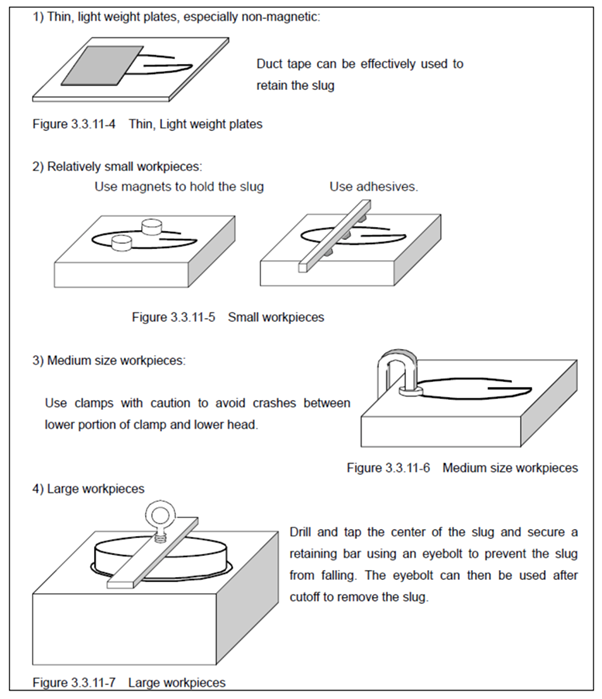There are several different techniques for holding and retaining material slugs. These methods will vary based upon the material type and size of the slug. It is important to have a slug management plan in place before machining begins, as it is imperative to prevent damage to the machine.
Some of the most common applications for securing slugs by using:
Rare Earth Magnets: These high-power magnets are a very convenient and inexpensive method to controlling most slugs on magnetic/ferrous materials. Several different sizes and powers of magnets are available, and more than one magnet can be used to retain a slug. For Wire EDM purposes, using a lower profile magnet will typically prevent interference and collision issues with the machine nozzles. While magnets are effective, they do have limitations! As a general rule, once a slug becomes larger than a 50mm (2.0”) cube or greater than 5kg (11 lbs.), additional support or retaining methods should be considered.
Adhesives: On smaller parts, glue or adhesive, such as Super Glue® or Bondo®, can be used to retain the workpiece or slug. This method would be reserved for smaller, lighter and more delicate part details, but a method for removing the adhesive must be determined before employing this method.
Tape: Using tape, such as duct tape, can be an effective method in controlling and retaining slugs. When machining thin material parts (part size dependent), it might be necessary to apply tape mid-process, as thin material can sag under its own weight, which will cause inaccuracies to the final part. If tape is applied mid-process, it is important to disable Automatic Wire Break recovery, as the machine could potentially crash or disturb the machine setup if the tape is placed near the program path.
Clamps: Using simple C-clamps or Kant Twist™ clamps can retain a slug and keep it from dropping. While effective, these clamps do hang below the table level, so extreme care should be taken to ensure that the machine will not crash into the clamps during operation or when moving the machine to extract the slug.
Top Straps: A flat bar of steel that is bolted to the slug before final cutoff and dropping of the slug is called a top strap. This method requires preplanning, as one or more tapped holes should be machined into the slug prior to Wire EDMing. Top straps are a very effective method of restraining larger and heavier slugs.
Slug Ejection via Programmable Flushing: On certain jobs where the slugs can freely fall away from the parent block, programmable flushing can be utilized to automatically eject the slug. Some Wire EDMs feature dual independent flush pumps, allowing the ability to program different flush pressures between the upper and lower heads. Depending on requirement, slugs can be pushed down and out of the bottom of the part (higher pressure on upper head – lower pressure on lower head), or slugs can be pushed up and out from the top (higher pressure on lower head – lower pressure on upper head). In either case, the use of programmable flush for automatic slug ejection is typically reserved for smaller sized slugs and the lower profile HEAT or laminar nozzle would be used.

One final question to consider when determining which method of slug retention is best, is: How much time it will take to remove the chosen method from the slug?
One example of this is having to remove Bondo adhesive from a slug. How much would this step add to the total production time—versus how much time it would take to remove a clamp or a top strap from the workpiece? In weighing two different methods, you may find that one might be much simpler to set up, but could greatly increase the finish time. It’s important to evaluate what’s involved in removing each restraint technique before deciding which one is best.